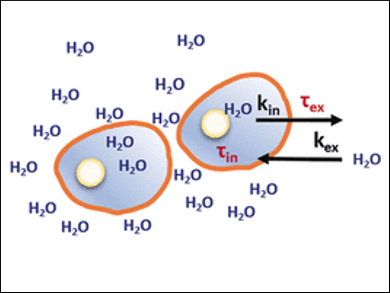How Aggressive is a Tumor?
To measure the status of a tumor without taking tissue samples, Simonetta Geninatti Crich, University of Torino, Italy, and colleagues have developed a method based on magnetic resonance imaging (MRI) of whole body parts. The technique measures proton nuclear resonance dispersion profiles at low magnetic fields, which reveals the water exchange rate of the tumor cells. Thus, tumor development can be monitored rapidly and noninvasively.
Clinically used high-field MRI can produce images of tumors with excellent spatial resolution. The images are acquired at a fixed magnetic field and reveal valuable data on the tumor morphology. However, dynamic processes such as tumor physiology and metabolism are not as easy to assess. This is a limitation that has been partially overcome by the administration of contrast agents, but a more direct method lies in the technique itself. The researchers used a field-cycling nuclear magnetic resonance (NMR) setup to measure the nuclear relaxation rates at low magnetic fields and found a clear correlation between water dynamics and tumor types.
Field-Cycling NMR Methods
NMR fast field-cycling techniques measure the relaxation time of protons, the dispersion profiles, after a sequence of magnetic cycles in a magnetic field. Depending on the strength of the magnetic field, different proton conditions can be probed. Water dynamics in a tumor, for example, are only accessible at the variable and low magnetic fields produced with these cycling techniques. In this study, the team used an adapted NMR instrument, which switches between different field strengths, for data acquisition on tumors in animal models. As a result, three different tumor models and healthy muscle tissue (the tumors were implemented in a leg of a mouse) produced distinct proton relaxation curves.
After analyzing the kinetics of the curves, the researchers identified three underlying scenarios: slow water exchange rate, fast exchange, and an intermediate exchange rate with contributions from both intra- and extracellular compartments. A fast exchange indicates a high metabolic rate and thus a high activity of the tumor cell. “This increased metabolic activity is characteristic for aggressive and highly metastatic tumor cells,” says Geninatti Crich. The tumor cells relieve their high metabolic pressure through an enhanced water exchange with the exterior of the cell. This parameter is now directly accessible.
The method enables the direct, fast, and noninvasive assessment of tumor status. The scientists describe the method as “a possibility for new diagnostic opportunities in oncology”. They plan to adopt it in the fast field-cycling MRI technologies that are currently developed for clinical use.
- Evidence for the Role of Intracellular Water Lifetime as a Tumour Biomarker Obtained by In Vivo Field-Cycling Relaxometry,
Maria Rosaria Ruggiero, Simona Baroni, Stefania Pezzana, Gianni Ferrante, Simonetta Geninatti Crich, Silvio Aime,
Angew. Chem. Int. Ed. 2018.
https://doi.org/10.1002/anie.201713318



